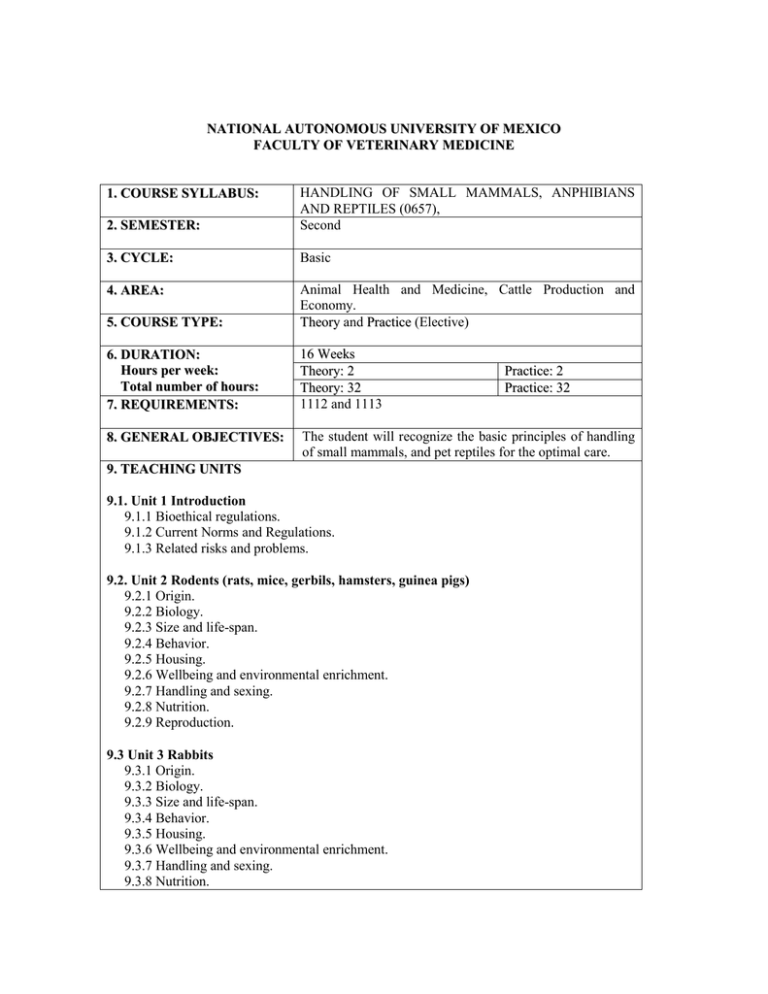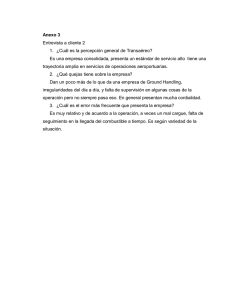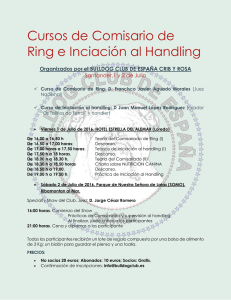HANDLING OF SMALL MAMMALS, ANPHIBIANS AND REPTILES.
Anuncio

NATIONAL AUTONOMOUS UNIVERSITY OF MEXICO FACULTY OF VETERINARY MEDICINE 2. SEMESTER: HANDLING OF SMALL MAMMALS, ANPHIBIANS AND REPTILES (0657), Second 3. CYCLE: Basic 4. AREA: 5. COURSE TYPE: Animal Health and Medicine, Cattle Production and Economy. Theory and Practice (Elective) 6. DURATION: Hours per week: Total number of hours: 7. REQUIREMENTS: 16 Weeks Theory: 2 Theory: 32 1112 and 1113 8. GENERAL OBJECTIVES: The student will recognize the basic principles of handling of small mammals, and pet reptiles for the optimal care. 1. COURSE SYLLABUS: 9. TEACHING UNITS 9.1. Unit 1 Introduction 9.1.1 Bioethical regulations. 9.1.2 Current Norms and Regulations. 9.1.3 Related risks and problems. 9.2. Unit 2 Rodents (rats, mice, gerbils, hamsters, guinea pigs) 9.2.1 Origin. 9.2.2 Biology. 9.2.3 Size and life-span. 9.2.4 Behavior. 9.2.5 Housing. 9.2.6 Wellbeing and environmental enrichment. 9.2.7 Handling and sexing. 9.2.8 Nutrition. 9.2.9 Reproduction. 9.3 Unit 3 Rabbits 9.3.1 Origin. 9.3.2 Biology. 9.3.3 Size and life-span. 9.3.4 Behavior. 9.3.5 Housing. 9.3.6 Wellbeing and environmental enrichment. 9.3.7 Handling and sexing. 9.3.8 Nutrition. Practice: 2 Practice: 32 9.3.9 Reproduction. 9.4 Unit 4 Ferrets 9.4.1 Origin. 9.4.2 Biology. 9.4.3 Size and life-span. 9.4.4 Behavior. 9.4.5 Housing. 9.4.6 Wellbeing and environmental enrichment. 9.4.7 Handling and sexing. 9.4.8 Nutrition. 9.4.9 Reproduction. 9.5 Unit 5 Hedgehogs 9.5.1 Origin. 9.5.2 Biology. 9.5.3 Size and life-span. 9.5.4 Behavior. 9.5.5 Housing. 9.5.6 Wellbeing and environmental enrichment. 9.5.7 Handling and sexing. 9.5.8 Nutrition. 9.5.9 Reproduction 9.6 Unit 6 Turtles 9.6.1 Origin. 9.6.2 Biology. 9.6.3 Size and life-span. 9.6.4 Behavior. 9.6.5 Housing. 9.6.6 Wellbeing and environmental enrichment. 9.6.7 Handling and sexing. 9.6.8 Nutrition. 9.6.9 Reproduction. 9.7 Unit 7 Iguanas 9.7.1 Origin. 9.7.2 Biology. 9.7.3 Size and life-span. 9.7.4 Behavior. 9.7.5 Housing. 9.7.6 Wellbeing and environmental enrichment. 9.7.7 Handling and sexing. 9.7.8 Nutrition. 9.7.9 Reproduction. 9.8 Unit 8 Snakes 9.8.1 Origin. 9.8.2 Biology. 9.8.3 Size and life-span. 9.8.4 Behavior. 9.8.5 Housing. 9.8.6 Wellbeing and environmental enrichment. 9.8.7 Handling and sexing. 9.8.8 Nutrition. 9.8.9 Reproduction. 10. BASIC BIBLIOGRAPHY 1. Barry, A.: Hámster. Hispano Europea. España, 1994. 2. Coborn, J.: Reptilles. Hispano Europea. España, 1994. 3. Desachy, F.: Los Nuevos Animales de Compañía. De Vecchi, S.A. España, 1999 4. Fox, J.G., Anderson, L.C., Loew, F.M., Quimby, F.W., eds. Laboratory Animal Medicine. 2nd Academic Press, New York, USA, 2002. 5. Gallimard, J.: El Ratón y Otros Roedores. Ediciones SM. España, 1994. 6. Gallimard, J. Y Houbre G.: La Tortuga. Ediciones SM. España, 1994. 7. Harknes, W.: Biología y Enfermedades de los Roedores y Conejos. Acribia. España 1999. 8. Kirk, J.: Terapéutica Veterinaria de Pequeños Animales. 13ª ed. McGrawHill / Interamericana de España, S.A., España, 2001. 9. Mettler, M.: Conejo Enano. Ediciones Tkal. España, 1994. 10. NOM-148-SCFI-2001. Prácticas comerciales elementos normativos para la comercialización de animales de compañía o de servicio, y para la prestación de servicios para su cuidado y / o adiestramiento. 11. NOM-059-SEMARNAT-2001 Norma Oficial Mexicana para la protección de especies y subespecies de flora y fauna en peligro de extinción 12. Taylor, D.: Pequeñas Mascotas. Editorial el Drac, S.L. España, 1999. 13. Villanueva, S.O. y Hernández, G.R.: Manual de Ciencia en Animales de Laboratorio. Instituto Nacional de Ciencias Médicas y Nutrición. SZ, México, 2004. 14. Barry, A.: Hámster. Hispano Europea. España, 1994. 15. Coborn, J.: Reptilles. Hispano Europea. España, 1994. 16. Desachy, F.: Los Nuevos Animales de Compañía. De Vecchi, S.A. España, 1999 17. Fox, J.G., Anderson, L.C., Loew, F.M., Quimby, F.W., eds. Laboratory Animal Medicine. 2nd Academic Press, New York, USA, 2002. 18. Gallimard, J.: El Ratón y Otros Roedores. Ediciones SM. España, 1994. 19. Gallimard, J. Y Houbre G.: La Tortuga. Ediciones SM. España, 1994. 20. Harknes, W.: Biología y Enfermedades de los Roedores y Conejos. Acribia. España 1999. 21. Kirk, J.: Terapéutica Veterinaria de Pequeños Animales. 13ª ed. McGrawHill / Interamericana de España, S.A., España, 2001. 22. Mettler, M.: Conejo Enano. Ediciones Tkal. España, 1994. 23. NOM-148-SCFI-2001. Prácticas comerciales elementos normativos para la comercialización de animales de compañía o de servicio, y para la prestación de servicios para su cuidado y / o adiestramiento. 24. NOM-059-SEMARNAT-2001 Norma Oficial Mexicana para la protección de especies y subespecies de flora y fauna en peligro de extinción 25. Taylor, D.: Pequeñas Mascotas. Editorial el Drac, S.L. España, 1999. 26. Villanueva, S.O. y Hernández, G.R.: Manual de Ciencia en Animales de Laboratorio. Instituto Nacional de Ciencias Médicas y Nutrición. SZ, México, 2004. 11. SUPLEMENTARY BIBLIOGRAPHY 1. Ballard B and Cheek R. Exotic medicine for the veterinary technician. Blackwell, Massachusetts, USA., 2003. 2. Barnar S. Reptile keeper’s handbook. Malabar ed. Florida, 1996. 3. Corbon J. Guia completa de los reptiles. Editorial Hispano Europea. Barcelona, 1994. 4. Gosden C. Exotics and wildlife: a manual of the veterinary nursing care. Butterworth Heinemann ed. Edinburgh, 2004. 5. Ferrel SK. Iguanas: cuidados, crianza, variedades. Editorial Hispano Europea. Barcelona, 1994. 6. Frye L. A practical guide for feeding captive reptiles. Malabar ed. Florida USA., 1991. 7. Frye FL. Biomedical and surgical of captive reptile husbandry. Malabar ed. Florida, 1991. 8. Nervio R. Serpientes: ejercicios, alimentación, cuidados, el terrario. Editorial Hispano Europea. Barcelona, 1994. 9. Richardson VC. Rabbits: health, husbandry and diseases. Blackwell ed. Massachusetts, 1996. 10. Richardson VC. Diseases of guinea pigs. Blackwell ed. Massachusetts, 1992. 11. Fowler ME and R.E. Miller: Zoo and Wild Animal Medicine. 5th ed. W.B. Saunders, USA, 2003. 12. Flecknell, p. manual of Rabbit medicine and Surgery. BSAVA.2000 13. Harkness and Wagner. The Biology and Medicine of rabbits and Rodents. 4th ed. Williams and Wilkins. 1995. Periodicals Veterinary Clinics of North America: Small Animal Practice. Veterinary Clinics of North America: Exotic animal practice. Laboratory Animal Science. 12. TEACHING METHODOLOGY Theory: Professor’s lecture with Q&A. Commented readings. Guided discussions. Practice: Demonstration. Exercises. Written exams. 13. COURSE EVALUATION Homeworks. Practice Reports. 14. REQUIREMENTS FOR TEACHING THE COURSE Veterinarian with postgraduate studies in the area or three years experience.

